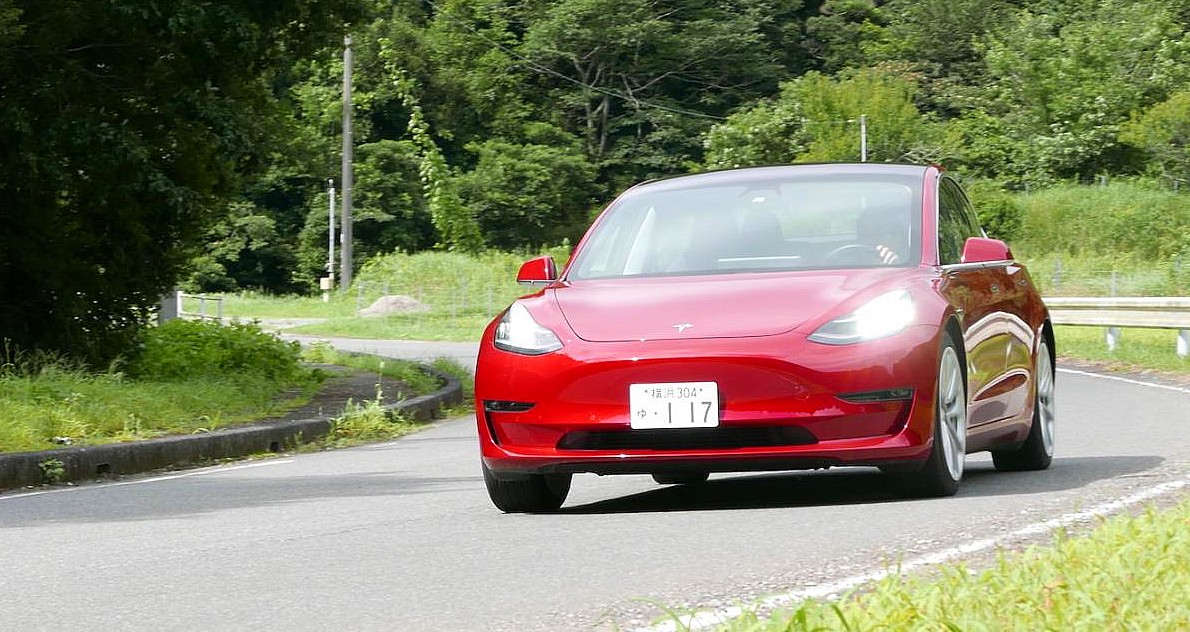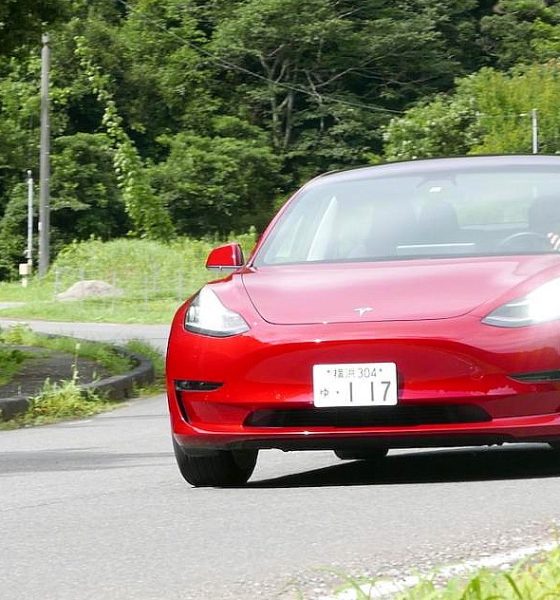

News
Tesla Model 3 gets Japanese car critic’s approval: ‘The excitement alone must be worth getting this car’
Since its release, the Tesla Model 3 has generally received positive reviews from both professional critics and enthusiasts alike. These reviews greatly help the vehicle, especially since Tesla relies on word of mouth due to the company’s stance against traditional advertisements. This means that one of the Model 3’s best chances of being successful relies on how well it is received by reviewers and owners alike.
With the Model 3 about to enter the Japanese market, the vehicle recently subjected to an evaluation by car critic Hitoshi Sezai from local motoring publication Motor-Fan.jp. Over the course of his time with the vehicle, the auto veteran found the Model 3 to be a completely different car than anything currently available on the market today. Sezai’s test unit was a Long Range Model 3 RWD, the first iteration of the vehicle released in the United States. In his review, the car critic took particular notice of the Model 3’s infotainment screen, which holds the vast majority of the vehicle’s functions.
Sezai likened the experience of using the Model 3’s display to his first impressions of the Apple iPad. According to the critic, when he first used an iPad, there was something immediately familiar and exciting about the system and how it freed users from the “mess of Windows.” This experience, Sezai noted, is echoed in the Model 3, as the vehicle gives drivers the impression that they are “in touch with a next-generation car.”
The critic also pointed out how different the Model 3 is compared to other EVs on the market. Using the best-selling Nissan Leaf as an example, Sezai stated that EVs are usually vehicles in “familiar packaging.” That is, they look like regular cars whose engines were replaced by electric motors. This was not the case with the Model 3, making the sedan very exciting to operate. “The Model 3 is a different thing. This excitement alone must be worth getting this car,” the critic wrote.
The critic admitted that he took some time before he got comfortable with the vehicle’s regenerative braking system (he was far more comfortable with a Standard setting), though he noted that the Model 3’s response and acceleration are impeccable. According to Sezai, the Model 3’s acceleration almost gives the impression that one is driving a ride from an amusement park: silent and very, very quick.
Most of the car critic’s observations about the Model 3 mirror that of reviews from enthusiasts who have recently experienced the vehicle. Earlier this month, Japanese EV enthusiasts who were able to take the Model 3 for a test drive praised the vehicle for its novel automated features and its all-electric performance, which some reviewers noted was superior to petrol-powered automobiles. Tesla, for its part, has started its promotional efforts in Japan, displaying the vehicle in several key cities.
The Tesla Model 3 is a best-selling vehicle in the United States, outselling rivals in the premium sedan segment such as the BMW M3. Considering the excitement surrounding the vehicle in nations such as Japan and South Korea, it appears that the Model 3 has a good shot at making an impact in the Asian region as well. In South Korea, for example, the Model 3 has started attracting large groups of people after it was made available in the country, especially after its starting price was lowered to just around $26,500 when national and select local subsidies are included.

News
Tesla FSD fleet is nearing 7 billion total miles, including 2.5 billion city miles
As can be seen on Tesla’s official FSD webpage, vehicles equipped with the system have now navigated over 6.99 billion miles.

Tesla’s Full Self-Driving (Supervised) fleet is closing in on almost 7 billion total miles driven, as per data posted by the company on its official FSD webpage.
These figures hint at the massive scale of data fueling Tesla’s rapid FSD improvements, which have been quite notable as of late.
FSD mileage milestones
As can be seen on Tesla’s official FSD webpage, vehicles equipped with the system have now navigated over 6.99 billion miles. Tesla owner and avid FSD tester Whole Mars Catalog also shared a screenshot indicating that from the nearly 7 billion miles traveled by the FSD fleet, more than 2.5 billion miles were driven inside cities.
City miles are particularly valuable for complex urban scenarios like unprotected turns, pedestrian interactions, and traffic lights. This is also the difference-maker for FSD, as only complex solutions, such as Waymo’s self-driving taxis, operate similarly on inner-city streets. And even then, incidents such as the San Francisco blackouts have proven challenging for sensor-rich vehicles like Waymos.
Tesla’s data edge
Tesla has a number of advantages in the autonomous vehicle sector, one of which is the size of its fleet and the number of vehicles training FSD on real-world roads. Tesla’s nearly 7 billion FSD miles then allow the company to roll out updates that make its vehicles behave like they are being driven by experienced drivers, even if they are operating on their own.
So notable are Tesla’s improvements to FSD that NVIDIA Director of Robotics Jim Fan, after experiencing FSD v14, noted that the system is the first AI that passes what he described as a “Physical Turing Test.”
“Despite knowing exactly how robot learning works, I still find it magical watching the steering wheel turn by itself. First it feels surreal, next it becomes routine. Then, like the smartphone, taking it away actively hurts. This is how humanity gets rewired and glued to god-like technologies,” Fan wrote in a post on X.
News
Tesla starts showing how FSD will change lives in Europe
Local officials tested the system on narrow country roads and were impressed by FSD’s smooth, human-like driving, with some calling the service a game-changer for everyday life in areas that are far from urban centers.

Tesla has launched Europe’s first public shuttle service using Full Self-Driving (Supervised) in the rural Eifelkreis Bitburg-Prüm region of Germany, demonstrating how the technology can restore independence and mobility for people who struggle with limited transport options.
Local officials tested the system on narrow country roads and were impressed by FSD’s smooth, human-like driving, with some calling the service a game-changer for everyday life in areas that are far from urban centers.
Officials see real impact on rural residents
Arzfeld Mayor Johannes Kuhl and District Administrator Andreas Kruppert personally tested the Tesla shuttle service. This allowed them to see just how well FSD navigated winding lanes and rural roads confidently. Kruppert said, “Autonomous driving sounds like science fiction to many, but we simply see here that it works totally well in rural regions too.” Kuhl, for his part, also noted that FSD “feels like a very experienced driver.”
The pilot complements the area’s “Citizen Bus” program, which provides on-demand rides for elderly residents who can no longer drive themselves. Tesla Europe shared a video of a demonstration of the service, highlighting how FSD gives people their freedom back, even in places where public transport is not as prevalent.
What the Ministry for Economic Affairs and Transport says
Rhineland-Palatinate’s Minister Daniela Schmitt supported the project, praising the collaboration that made this “first of its kind in Europe” possible. As per the ministry, the rural rollout for the service shows FSD’s potential beyond major cities, and it delivers tangible benefits like grocery runs, doctor visits, and social connections for isolated residents.
“Reliable and flexible mobility is especially vital in rural areas. With the launch of a shuttle service using self-driving vehicles (FSD supervised) by Tesla in the Eifelkreis Bitburg-Prüm, an innovative pilot project is now getting underway that complements local community bus services. It is the first project of its kind in Europe.
“The result is a real gain for rural mobility: greater accessibility, more flexibility and tangible benefits for everyday life. A strong signal for innovation, cooperation and future-oriented mobility beyond urban centers,” the ministry wrote in a LinkedIn post.
News
Tesla China quietly posts Robotaxi-related job listing
Tesla China is currently seeking a Low Voltage Electrical Engineer to work on circuit board design for the company’s autonomous vehicles.

Tesla has posted a new job listing in Shanghai explicitly tied to its Robotaxi program, fueling speculation that the company is preparing to launch its dedicated autonomous ride-hailing service in China.
As noted in the listing, Tesla China is currently seeking a Low Voltage Electrical Engineer to work on circuit board design for the company’s autonomous vehicles.
Robotaxi-specific role
The listing, which was shared on social media platform X by industry watcher @tslaming, suggested that Tesla China is looking to fill the role urgently. The job listing itself specifically mentions that the person hired for the role will be working on the Low Voltage Hardware team, which would design the circuit boards that would serve as the nervous system of the Robotaxi.
Key tasks for the role, as indicated in the job listing, include collaboration with PCB layout, firmware, mechanical, program management, and validation teams, among other responsibilities. The role is based in Shanghai.
China Robotaxi launch
China represents a massive potential market for robotaxis, with its dense urban centers and supportive policies in select cities. Tesla has limited permission to roll out FSD in the country, though despite this, its vehicles have been hailed as among the best in the market when it comes to autonomous features. So far, at least, it appears that China supports Tesla’s FSD and Robotaxi rollout.
This was hinted at in November, when Tesla brought the Cybercab to the 8th China International Import Expo (CIIE) in Shanghai, marking the first time that the autonomous two-seater was brought to the Asia-Pacific region. The vehicle, despite not having a release date in China, received a significant amount of interest among the event’s attendees.








